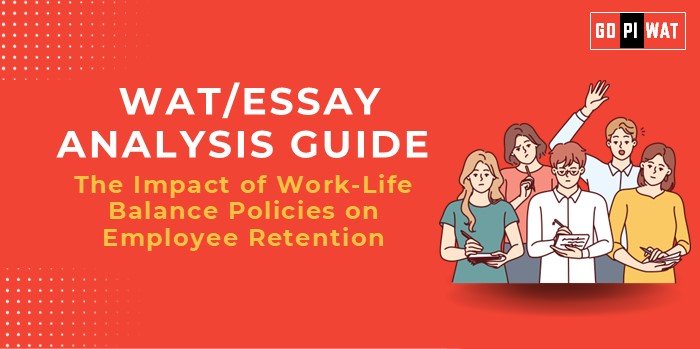📋 The Impact of Work-Life Balance Policies on Employee Retention
🌐 Understanding Work-Life Balance’s Importance
Work-life balance policies are critical in today’s corporate environment, directly impacting employee retention, mental health, and productivity. As workplaces evolve, businesses must align these policies with organizational goals to ensure long-term success and employee satisfaction.
📝 Effective Planning and Writing
- ⏳ Time Allocation: Planning: 5 minutes | Writing: 20 minutes | Reviewing: 5 minutes
- 📚 Structure:
- Introduction: 60-70 words
- Body: 350-375 words (Achievements, Challenges, Future Outlook)
- Conclusion: 60-70 words
💡 Introduction Techniques for Essays
- 🔄 Contrast Approach: “While technological advancements offer flexibility, the absence of work-life balance policies has led to unprecedented burnout among employees globally.”
- 🔧 Solution-Based Approach: “Organizations adopting innovative work-life balance policies are achieving lower attrition rates, setting new standards for employee satisfaction and productivity.”
📊 Structuring the Essay Body
🏆 Achievements
- 📈 Higher Retention: Companies with robust work-life balance policies report a 40% improvement in retention rates.
- 😊 Improved Productivity: Employees with flexible schedules perform better and experience reduced stress levels.
- 💡 Employee Satisfaction: Policies like remote work, hybrid models, and wellness initiatives foster happier workplaces.
⚠️ Challenges with Comparative Analysis
- 🔍 Implementation Issues: Difficulties arise in balancing workloads and preventing work spillover into personal time.
- 🌍 Cultural Resistance: In regions like Japan, work-life balance policies clash with entrenched overwork cultures.
- 📖 Global Comparison: Sweden’s 4-day workweek showed success, whereas Japan struggles with overwork-related burnout.
🔮 Future Outlook
- 🤖 AI Integration: Workload management tools and AI-driven systems can optimize employee schedules.
- 🏢 Hybrid Models: Strategic hybrid structures allow employees to balance remote and in-office work effectively.
- 📅 Innovative Structures: Flexible work hours and results-oriented cultures are becoming the new norm.
📄 Concluding Effectively
- ⚖️ Balanced Perspective: “Work-life balance policies are essential for employee retention but require tailored implementation to overcome industry-specific challenges.”
- 🌍 Global Comparison: “As seen in countries like Sweden and Japan, tailored approaches to work-life policies offer valuable lessons for global organizations.”
📚 Sample Short Essays
⚖️ Balanced Perspective
Work-life balance policies have revolutionized modern workplaces by improving retention rates and employee satisfaction. However, successful implementation requires addressing challenges like cultural norms and work spillover.
🔍 Solution-Oriented
Organizations adopting flexible work models report a 40% improvement in retention. Strategic hybrid schedules, workload management tools, and wellness programs can optimize work-life balance outcomes.
🌍 Global Comparison
While Sweden’s 6-hour workday model improved productivity, Japan’s struggle with overwork highlights the need for industry-specific work-life balance strategies.
🔑 Recommendations for Sustainable Progress
- 📌 Tailor Policies: Design work-life balance initiatives to suit industry and workforce needs.
- 🤖 Leverage Technology: Use AI tools to manage workloads and prevent burnout.
- 🎯 Promote Results-Oriented Cultures: Shift focus from fixed work hours to achieving measurable outcomes.
📈 Analyzing Successes and Shortcomings
- ✅ Achievements: Improved productivity, reduced attrition, and enhanced well-being.
- ⚠️ Challenges: Policy gaps, cultural resistance, and remote work burnout.
- 🌍 Global Context: Successful 4-day workweeks (Sweden), struggles with overwork (Japan).


